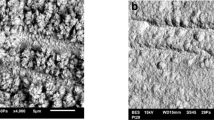Abstract
The preparation of glass insulated platinum electrodes, described byWohlbarsht et al. (1960), has been improved by following the different steps of the procedure quantitatively: electrolytic sharpening, coating with molten glass and exposing and platinizing the tip. Etching at 12 V r.m.s in a slightly undersaturated sodium cynanide solution down to 30 per cent of the initial etching current gave the best electrode shape and surface properties. To coat the tip of the electrode with glass required a narrow temperature range. The temperature of the molten glass was gauged from the resistance of the platinum heating loop measured in a Wheatstone bridge. The insulation of the electrode was tested by measuring the capacitance between the platinum core and an outer fluid. To remove the glass from the tip of the microelectrode and to platinize the tip a negative rectangular pulse of 0·1 sec duration was applied to the electrode placed in 0·1 per cent chloroplatinic acid. 8–15 V pulses resulted in electrode impedances of about 20–1 MΩ as measured by means of a ramp pulse applied to the electrode via a small condenser. In cerebral cortex the platinum electrodes found more units which had amplitudes larger than 1 mV than the glass pipette electrodes. Metal electrodes with high impedance could hold more units for longer than five minutes than could glass pipette electrodes with high impedance.
Sommaire
La méthode de préparation d'électrodes en platine avec isolant en verre, décrite parWohlbrasht et al. (1960), a été améliorée en employant un dosage judicieux à chaque echelon de la procédure: affilage électrolytique, recouvrement par verre coulé, exposition et platinage de la pointe. L'attaque à 12 V RMC dans une solution de Cyanure de Sodium, légèrement sous-saturée, ramenée à 30% du courant attaquant initial, a donné les meilleurs résultants quant à la forme et la surface de l'électrode. Le recouvrement par verre de la pointe de l'électrode a nécessité une détermination précise de la température. La température du verre coulé a été définie d'après la résistance de la boucle chauffante de platine, mesurée dans un pont de Wheatstone. L'isolation de l'électrode a été éprouvée en mesurant la capacitance entre le noyan de platine et un corps fluide extérieur. Afin d'enlever le verre de la pointe et la platiner, la micro-électrode a été placée dans une solution à 1% d'acide chloreplatine et soumise à une impulsion négative rectangulaire d'une durée de 0,1 sec. Des impulsions de 8–15 V ont provoqué des impédances de l'électrode l'environ 20 MΩ, selon les mesures prises. Il a été constaté que les électrodes de platine détectent, dans le cortex cérébral, des ondes d'amplitude supérieure à 1 mV en plus grand nombre que les électrodes en verre. Des électrodes en métal à haute impédance peuvent rentenir les valeurs pendant 5 min de plus que les électrodes en verre à haute impédance.
Zusammenfassung
Die vonWohlbarsht et al. (1960) beschriebene Herstellung glasisolierter Platin-Elektroden wurde durch folgendes Verfahren quantitativ verbessert: elektrolytisches Schärfen, Überziehen mit geschmolzenem Glas, Freilegen der Spitze und Überziehen mit Platin. Ätzung bei 12Veff in einer leicht ungesättigten Natriumcyanidlösung durch einen bis auf 30% des ursprünglichen Wertes abnehmenden Atzstrom ergab die beste Elektrodenform und die besten Oberflächeneigenschaften. Das Überziehen der Elektrodenspitze mit Glas erforderte einen definierten Temperaturbereich. Die Temperatur des geschmolzenen Glases wurde über den mit einer Wheatstoneschen Brücke gemessenen Widerstand der Platinheizschleife bestimmt. Die Isolierung der Elektrode wurde durch Messung der Kapazität zwischen Platinkern und Flüssigkeit nachgeprüft. Um das Glas von der Spitze zu entfernen und um diese mit Platin zu überziehen, wurde die sich in einer 0,1 prozentigen Chloroplatinsäure befindliche Elektrode einem negativen Rechteckimpuls von 0,1 sec Dauer ausgesetzt. 8–15 V Impulse ergaben Elektrodenimpedanzen von ungefähr 20 mΩ, die mittels eines durch einen kleinen Kondensator an die Elektrode gelegten Stufenimpulses gemessen wurden. In der Hirnrinde erhielt man bei Platin-Elektroden mehr Werte mit Amplituden über 1 mV als bei Glas-Pipettenelektroden. Metallelektroden, hoher Impedanz konnten mehr Werte über fünf Minuten speichern als Glas-Pipettenelektroden hoher Impedanz.
Similar content being viewed by others
References
Frank, K. (1959)Identification and analysis of single unit activity in the central nervous system. Chapter X in Handbook of Physiology, Section 1: Neurophysiology, Vol. 1, pp. 261–277. American Physiological Society, Washington, D.C.
Gesteland, R. C., Howland, B., Lettvin, J. Y. andPitts, W. H. (1959) Comments on microelectrodes.Proc. Inst. Radio Engngs.,47, 1856–1862.
Guld, C. (1962) Cathode follower and negative capacitance as high input impedance circuits.Proc. Inst. Radio Engngrs.,50, 1912–1927.
Hubel, D. H. (1957) Tungsten microelectrode for recording from single units.Science,125, 549–550.
Rose, J. E. andMountcastle, V. B. (1954) Activity of single neurons in the tactile thalamic region of the cat in response to a transient peripheral stimulus.Johns Hopk. Hosp. Bull.,94, 238–282.
Wohlbarsht, M. L., MacNichol, E. F., Jr. andWagner, H. G. (1960) Glass insulated platinum microelectrode.Science,132, 1309–1310.
Author information
Authors and Affiliations
Additional information
This investigation was supported in part by Public Health Service Grant NB-3943-01 from the Division of Research Grants.
The Russian translation of the abstract to this paper will be printed in a loose-leaf insert to be distributed with the next issue of the Journal.
Rights and permissions
About this article
Cite this article
Guld, C. A glass-covered platinum microelectrode. Med. Electron. Biol. Engng 2, 317–327 (1964). https://doi.org/10.1007/BF02474628
Issue Date:
DOI: https://doi.org/10.1007/BF02474628




